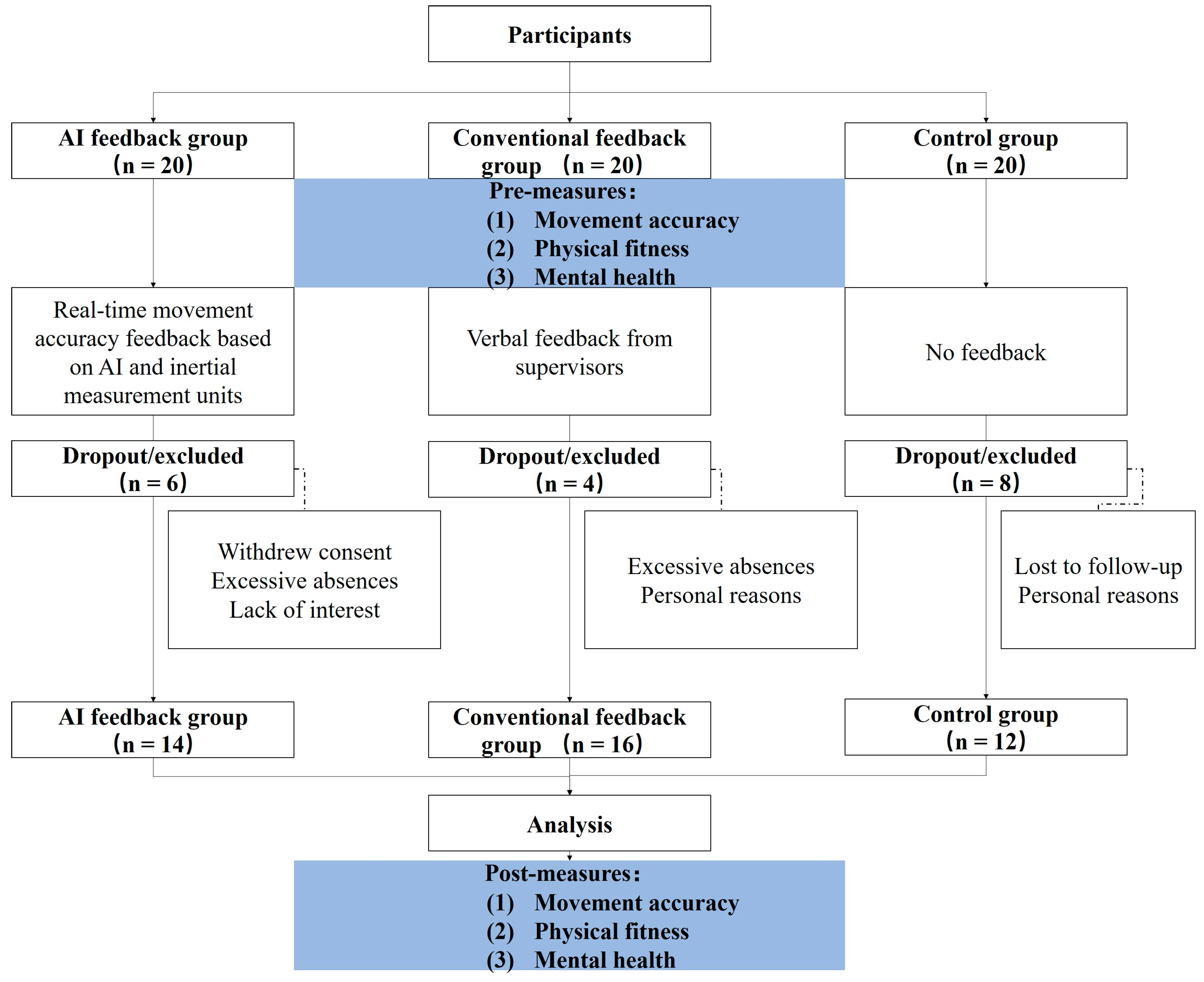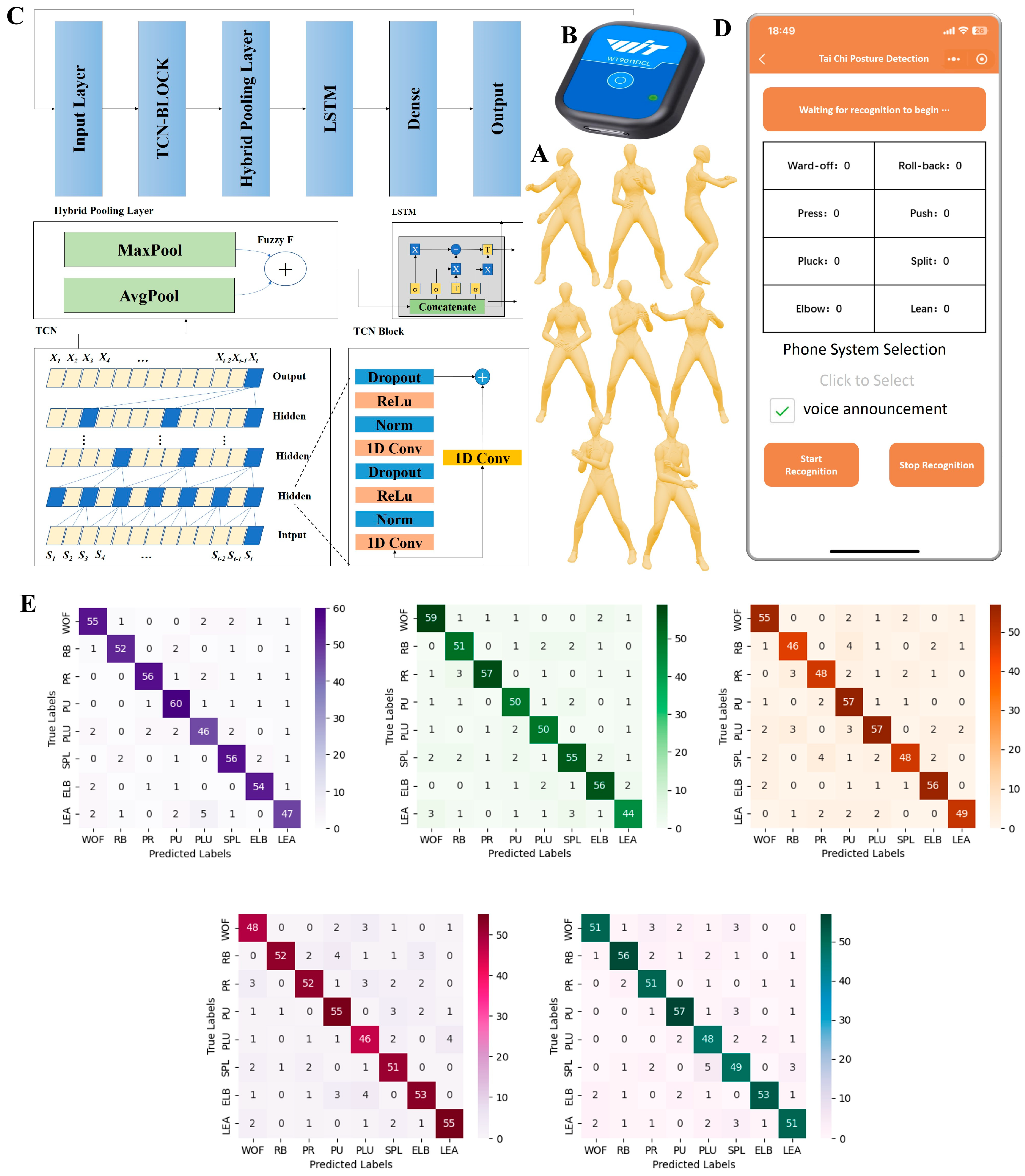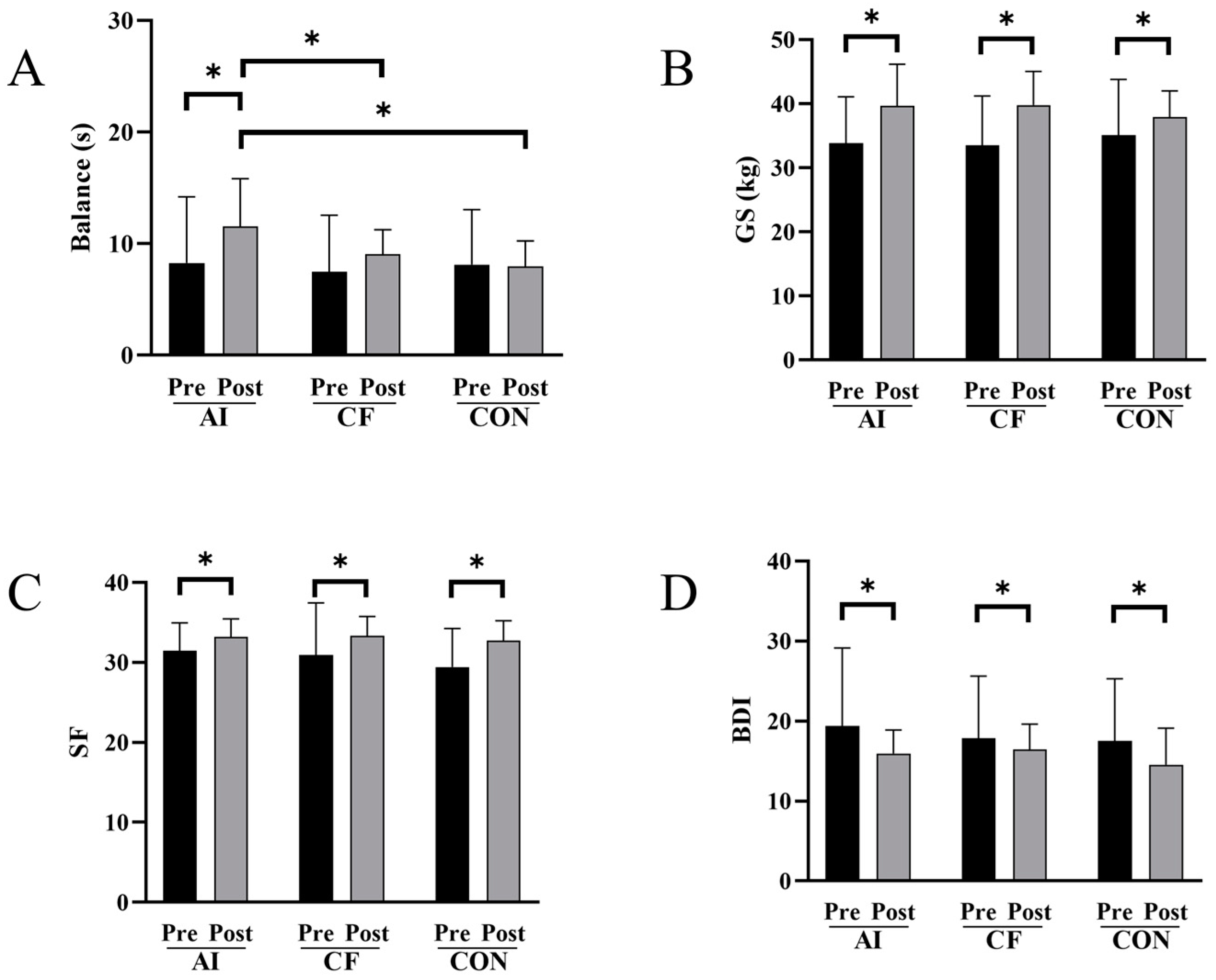The Effect of Tai Chi (Bafa Wubu) Training and Artificial Intelligence-Based Movement-Precision Feedback on the Mental and Physical Outcomes of Elderly
Abstract
:1. Introduction
2. Participants and Method
2.1. Participants
2.2. Method
2.2.1. Study Design
2.2.2. Tai Chi (Bafa Wubu) Exercise
2.2.3. AI Feedback Implementation Process
2.2.4. Outcome Measures
2.3. Statistical Analysis
3. Results
4. Discussion
5. Conclusions
Supplementary Materials
Author Contributions
Funding
Institutional Review Board Statement
Informed Consent Statement
Data Availability Statement
Conflicts of Interest
References
- Ghenţa, M.; Matei, A.; Mladen-Macovei, L.; Stănescu, S. Quality of Life of Older Persons: The Role and Challenges of Social Services Providers. Int. J. Environ. Res. Public Health 2022, 19, 8573. [Google Scholar] [CrossRef] [PubMed]
- Hou, B.; Wu, Y.; Huang, Y. Physical exercise and mental health among older adults: The mediating role of social competence. Front. Public Health 2024, 12, 1385166. [Google Scholar] [CrossRef] [PubMed]
- Liimatta, H.; Lampela, P.; Laitinen-Parkkonen, P.; Pitkala, K. Effects of preventive home visits on older people’s use and costs of health care services: A systematic review. Eur. Geriatr. Med. 2016, 7, 571–580. [Google Scholar] [CrossRef]
- Zhao, X.-G. Age score for assessing motor function in Chinese older men. J. Men’s Health 2020, 17, 37–43. [Google Scholar] [CrossRef]
- Musculus, L.; Kinrade, N.; Laborde, S.; Gleißert, M.; Streich, M.; Lobinger, B.H. Movement-Specific Reinvestment in Older People Explains Past Falls and Predicts Future Error-Prone Movements. Int. J. Environ. Res. Public Health 2021, 18, 5129. [Google Scholar] [CrossRef] [PubMed]
- Contreras-Vidal, J.L.; Teulings, H.; Stelmach, G. Elderly subjects are impaired in spatial coordination in fine motor control. Acta Psychol. 1998, 100, 25–35. [Google Scholar] [CrossRef]
- Nicklas, B.J.; Brinkley, T.E. Exercise Training as a Treatment for Chronic Inflammation in the Elderly. Exerc. Sport Sci. Rev. 2009, 37, 165–170. [Google Scholar] [CrossRef]
- Weisser, B.; Preuß, M.; Predel, H.-G. Physical Activity for Prevention and Therapy of Internal Diseases in the Elderly. Med. Klin. Intensivmed. Notfallmedizin 2009, 104, 296–302. [Google Scholar] [CrossRef]
- Jimenez, P.; Melendez, A.; Albers, U. Psychological effects of Tai Chi Chuan. Arch. Gerontol. Geriatr. 2012, 55, 460–467. [Google Scholar] [CrossRef]
- Park, C. Mind-Body CAM Interventions: Current Status and Considerations for Integration into Clinical Health Psychology. J. Clin. Psychol. 2013, 69, 45–63. [Google Scholar] [CrossRef]
- Chan, A.W.; Lee, A.; Lee, D.T.; Suen, L.K.; Tam, W.W.; Chair, S.; Griffiths, P. The sustaining effects of Tai chi Qigong on physiological health for COPD patients: A randomized controlled trial. Complement. Ther. Med. 2013, 21, 585–594. [Google Scholar] [CrossRef] [PubMed]
- Wayne, P.M.; Manor, B.; Novak, V.; Costa, M.D.; Hausdorff, J.M.; Goldberger, A.L.; Ahn, A.C. A systems biology approach to studying Tai Chi, physiological complexity and healthy aging: Design and rationale of a pragmatic randomized controlled trial. Contemp. Clin. Trials 2013, 34, 21–34. [Google Scholar] [CrossRef] [PubMed]
- Kasim, N.F.; Veldhuijzen van Zanten, J.; Aldred, S. Tai Chi is an effective form of exercise to reduce markers of frailty in older age. Exp. Gerontol. 2020, 135, 110925. [Google Scholar] [CrossRef]
- Cheng, Y. Effect of Tai Chi-Based Psychosomatic Rehabilitation Exercise on Physiological Function and Mental Health of Patients with Coronary Heart Disease: A Meta-Analysis. Rev. Cardiovasc. Med. 2024, 25, 227. [Google Scholar] [CrossRef]
- Li, X.; Zou, L.; Li, H. Tai Chi Movement Recognition and Precise Intervention for the Elderly Based on Inertial Measurement Units and Temporal Convolutional Neural Networks. Sensors 2024, 24, 4208. [Google Scholar] [CrossRef] [PubMed]
- Zhang, J.; Gao, T.; Li, Y.; Song, Z.; Cui, M.; Wei, Q.; Chen, Z.; Peng, F.; Lyu, S. The effect of Bafa Wubu of Tai Chi on college students’ anxiety and depression: A randomized, controlled pilot study. Front. Physiol. 2023, 14, 1036010. [Google Scholar] [CrossRef]
- Klimstra, M.; Geneau, D.; Lacroix, M.; Jensen, M.; Greenshields, J.; Cormier, P.; Brodie, R.; Commandeur, D.; Tsai, M.-C. Wheelchair Rugby Sprint Force-Velocity Modeling Using Inertial Measurement Units and Sport Specific Parameters: A Proof of Concept. Sensors 2023, 23, 7489. [Google Scholar] [CrossRef]
- Armitage, M.; Beato, M.; McErlain-Naylor, S.A. Inter-unit reliability of IMU Step metrics using IMeasureU Blue Trident inertial measurement units for running-based team sport tasks. J. Sports Sci. 2021, 39, 1512–1518. [Google Scholar] [CrossRef]
- Dadashi, F.; Crettenand, F.; Millet, G.P.; Aminian, K. Front-Crawl Instantaneous Velocity Estimation Using a Wearable Inertial Measurement Unit. Sensors 2012, 12, 12927–12939. [Google Scholar] [CrossRef]
- Sara, L.K.; Outerleys, J.; Johnson, C.D. The Effect of Sensor Placement on Measured Distal Tibial Accelerations during Running. J. Appl. Biomech. 2023, 39, 199–203. [Google Scholar] [CrossRef]
- King, K.; Yoon, S.; Perkins, N.; Najafi, K. Wireless MEMS inertial sensor system for golf swing dynamics. Sens. Actuators 2008, 141, 619–630. [Google Scholar] [CrossRef]
- Oi, K.; Nakamura, Y.; Matsuda, Y.; Fujimoto, M.; Yasumoto, K. Inertial Measurement Unit-sensor-based Short Stick Exercise Tracking to Improve Health of Elderly People. Sens. Mater. 2022, 34, 2911–2928. [Google Scholar] [CrossRef]
- Sun, Y.; Jiang, T. An Epileptic Seizure Detection Method Based on TCN-LSTM. In Proceedings of the 2023 4th International Symposium on Artificial Intelligence for Medicine Science, Chengdu, China, 27–29 October 2023; pp. 48322–48385. [Google Scholar] [CrossRef]
- Tu, C.; Zhou, F.; Pan, M. A model with high-precision on proton exchange membrane fuel cell performance degradation prediction based on temporal convolutional network-long short-term memory. Int. J. Hydrogen Energy 2024, 74, 414–422. [Google Scholar] [CrossRef]
- Bonett, D.G. Sample Size Requirements for Testing and Estimating Coefficient Alpha. J. Educ. Behav. Stat. 2002, 27, 335–340. [Google Scholar] [CrossRef]
- Nagashima, K.; Makioka, K.; Fujita, Y.; Ikeda, M.; Ikeda, Y. Clinical usefulness of scales for evaluating cognitive impairment in patients with amyotrophic lateral sclerosis. J. Neurol. Sci. 2019, 405, 116414. [Google Scholar] [CrossRef]
- Li, B.; Tang, H.; He, G.; Jin, Z.; He, Y.; Huang, P.; He, N.; Chen, S. Tai Chi enhances cognitive training effects on delaying cognitive decline in mild cognitive impairment. Alzheimer’s Dementia J. Alzheimer’s Assoc. 2023, 19, 136–149. [Google Scholar] [CrossRef]
- Maciaszek, J.; Osiński, W. The Effects of Tai Chi on Body Balance in Elderly People—A Review of Studies from the Early 21st Century. Am. J. Chin. Med. 2010, 38, 219–229. [Google Scholar] [CrossRef]
- Song, Q.; Tian, X.; Wong, D.; Zhang, C.; Sun, W.; Cheng, P.; Mao, D. Effects of Tai Chi Exercise on body stability among the elderly during stair descent under different levels of illumination. Res. Sports Med. 2017, 25, 197–208. [Google Scholar] [CrossRef]
- Tsang, W.W.N.; Hui-Chan, C.W.Y. Effects of Tai Chi on Joint Proprioception and Stability Limits in Elderly Subjects. Med. Sci. Sports Exerc. 2003, 35, 1962–1971. [Google Scholar] [CrossRef]
- Lin, J.; Ning, S.; Lyu, S.; Gao, H.; Shao, X.; Tan, Z.; Zhu, X.; Chen, Y. The effects of different types of Tai Chi exercises on preventing falls in older adults: A systematic review and network meta-analysis. Aging Clin. Exp. Res. 2024, 36, 65. [Google Scholar] [CrossRef]
- Yan, Z.-W.; Yang, Z.; Yang, J.; Chen, Y.-F.; Zhang, X.-B.; Song, C.-L. Tai Chi for spatiotemporal gait features and dynamic balancing capacity in elderly female patients with non-specific low back pain: A six-week randomized controlled trial. J. Back Musculoskelet. Rehabil. 2022, 35, 1311–1319. [Google Scholar] [CrossRef] [PubMed]
- Lei, H.; Ma, Z.; Tian, K.; Liu, K.; Wang, J.; Zhu, X.; Mi, B.; Chen, Y.; Yang, Q.; Jiang, H. The effects of different types of Tai Chi exercises on motor function in patients with Parkinson’s disease: A network meta-analysis. Front. Aging Neurosci. 2022, 14, 936027. [Google Scholar] [CrossRef] [PubMed]
- Cai, Z.; Cai, R.; Sen, L. Effects of different types of physical exercise on executive function of older adults: A scoping review. Front. Psychol. 2024, 15, 1376688. [Google Scholar] [CrossRef] [PubMed]
- Schumann, F.; Steinborn, M.B.; Kürten, J.; Cao, L.; Händel, B.F.; Huestegge, L. Restoration of Attention by Rest in a Multitasking World: Theory, Methodology, and Empirical Evidence. Front. Psychol. 2022, 13, 867978. [Google Scholar] [CrossRef] [PubMed]



| AI Feedback Group (n = 14) | Conventional Feedback Group (n = 16) | Control Group (n = 12) | Interaction | ||||||||
|---|---|---|---|---|---|---|---|---|---|---|---|
| Pre | Post | p | Pre | Post | p | Pre | Post | p | p | η2p | |
| Ward-off (%) | 9.885 ± 3.708 | 82.221 ± 6.231 | 0.000 | 10.844 ± 4.014 | 77.111 ± 4.167 a | 0.000 | 11.599 ± 2.660 | 75.649 ± 2.404 ab | 0.000 | 0.003 | 0.263 |
| Roll-back (%) | 13.606 ± 6.448 | 82.197 ± 7.812 | 0.000 | 14.249 ± 6.968 | 75.875 ± 3.696 a | 0.000 | 13.217 ± 6.766 | 75.309 ± 2.476 ab | 0.000 | 0.205 | 0.078 |
| Press (%) | 24.850 ± 6.148 | 79.445 ± 3.619 | 0.000 | 24.272 ± 7.142 | 78.841 ± 3.569 | 0.000 | 21.736 ± 6.421 | 79.355 ± 2.445 | 0.000 | 0.441 | 0.041 |
| Push (%) | 19.737 ± 9.074 | 79.805 ± 6.051 | 0.000 | 17.888 ± 9.097 | 78.046 ± 8.021 | 0.000 | 15.213 ± 7.367 | 76.970 ± 9.103 | 0.000 | 0.899 | 0.005 |
| Pluck (%) | 14.090 ± 7.006 | 87.526 ± 5.692 | 0.000 | 12.343 ± 7.999 | 80.033 ± 5.50 a | 0.000 | 11.695 ± 8.145 | 75.032 ± 11.770 ab | 0.000 | 0.275 | 0.064 |
| Split (%) | 18.209 ± 5.252 | 77.239 ± 8.304 | 0.000 | 20.802 ± 4.708 | 77.297 ± 10.313 | 0.000 | 16.610 ± 6.450 | 74.174 ± 5.405 | 0.000 | 0.812 | 0.011 |
| Elbow (%) | 18.209 ± 5.252 | 81.392 ± 11.228 | 0.000 | 20.802 ± 4.708 | 77.779 ± 10.336 | 0.000 | 16.610 ± 6.450 | 75.487 ± 5.230 | 0.000 | 0.251 | 0.068 |
| Lean (%) | 18.209 ± 5.252 | 88.409 ± 7.391 | 0.000 | 20.802 ± 4.708 | 82.694 ± 7.546 | 0.000 | 16.610 ± 6.450 | 83.907 ± 10.624 | 0.000 | 0.121 | 0.103 |
| Balance(s) | 8.270 ± 5.930 | 11.545 ± 4.260 | 0.047 | 7.470 ± 5.075 | 9.071 ± 2.158 a | 0.330 | 8.120 ± 4.924 | 7.966 ± 4.269 ab | 0.935 | 0.414 | 0.044 |
| Grip strength (kg) | 33.875 ± 7.231 | 39.706 ± 6.480 | 0.028 | 33.539 ± 7.676 | 39.816 ± 5.240 | 0.012 | 35.110 ± 8.711 | 37.928 ± 4.091 | 0.046 | 0.607 | 0.025 |
| SF-12 | 31.493 ± 3.472 | 33.220 ± 2.224 | 0.049 | 30.966 ± 6.480 | 33.361 ± 2.383 | 0.000 | 29.415 ± 4.830 | 32.752 ± 2.453 | 0.035 | 0.742 | 0.015 |
| BDI | 19.390 ± 9.765 | 15.935 ± 2.962 | 0.005 | 17.848 ± 7.754 | 16.451 ± 3.155 | 0.045 | 17.523 ± 7.773 | 14.565 ± 4.562 | 0.010 | 0.785 | 0.012 |
Disclaimer/Publisher’s Note: The statements, opinions and data contained in all publications are solely those of the individual author(s) and contributor(s) and not of MDPI and/or the editor(s). MDPI and/or the editor(s) disclaim responsibility for any injury to people or property resulting from any ideas, methods, instructions or products referred to in the content. |
© 2024 by the authors. Licensee MDPI, Basel, Switzerland. This article is an open access article distributed under the terms and conditions of the Creative Commons Attribution (CC BY) license (https://creativecommons.org/licenses/by/4.0/).
Share and Cite
Zhang, Y.; Li, H.; Huang, R. The Effect of Tai Chi (Bafa Wubu) Training and Artificial Intelligence-Based Movement-Precision Feedback on the Mental and Physical Outcomes of Elderly. Sensors 2024, 24, 6485. https://doi.org/10.3390/s24196485
Zhang Y, Li H, Huang R. The Effect of Tai Chi (Bafa Wubu) Training and Artificial Intelligence-Based Movement-Precision Feedback on the Mental and Physical Outcomes of Elderly. Sensors. 2024; 24(19):6485. https://doi.org/10.3390/s24196485
Chicago/Turabian StyleZhang, Yuze, Haojie Li, and Rui Huang. 2024. "The Effect of Tai Chi (Bafa Wubu) Training and Artificial Intelligence-Based Movement-Precision Feedback on the Mental and Physical Outcomes of Elderly" Sensors 24, no. 19: 6485. https://doi.org/10.3390/s24196485







